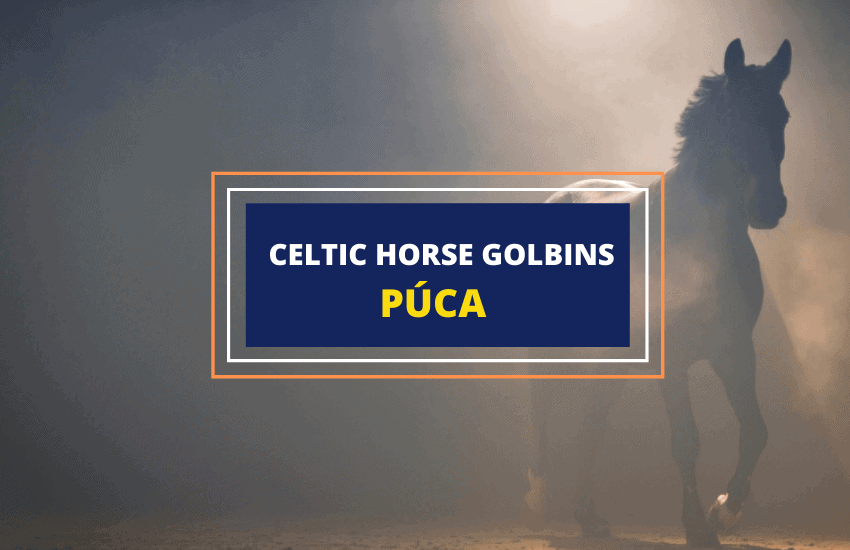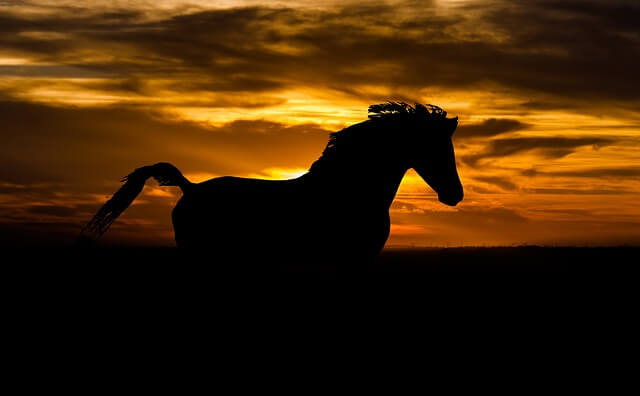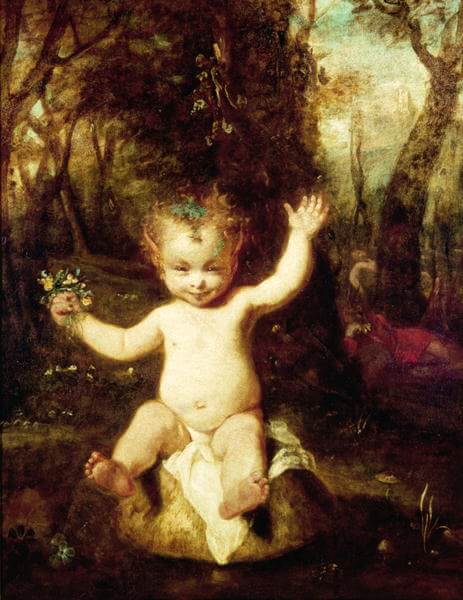
Table of Contents
A galloping black stallion is a gorgeous sight to behold but not if you’re in Ireland after dark. The mythical púca black horses of Irish mythology have terrified the people of Ireland and other Celtic ethnicities for centuries but plagued farmers in particular. One of the most popular creatures of Celtic mythology, the pooka has inspired modern culture in many ways. What is the mystery behind these creatures and how did they originate?
What Is The Púca?
Púca, in Old Irish, literally translates as a goblin. Today, it’s commonly spelled pooka, with púcai being the technical plural form. Another theory about the pooka’s name is that it comes from Poc i.e. he-goat in Irish.
These menacing creatures usually come in the shape of a black horse and they roam the countryside tirelessly, looking for people to torment. They rarely went as far as to kill someone, but they are said to cause much property damage and mischief, as well as cause misfortune in general.
What Did the Pooka Do?

The most common myth about the pooka is that they look for people at night and try to trick the poor folks into riding them. The usual victim of the pooka will be a drunk who didn’t get home soon enough, a farmer who had to do some work in the field after dark, or children who didn’t get home for dinner.
The pooka would usually try to convince the person into riding it but in some myths, the beast would just toss them on its back and start running. This midnight run would usually go on until dawn when the pooka would return the victim to where it took them from and leave them there dazed and confused. The victim would rarely be killed or even physically harmed, but they’d be given a terrifying nightmare of a ride. According to some myths, the rider would also be cursed with bad luck.
How to Stop the Pooka
There are a few popular countermeasures people took against the pookah horses, aside from simply trying to get home before dusk. The most common would be to wear “sharp things”, such as spurs, to try and stop the animal from abducting them, or at least to have some control over it during the ride.
In Seán Ó Cróinín’s story An Buachaill Bó agus an Púca, a boy gets taken by a pooka and stabs the animal with his spurs. The pooka throws the youth to the ground and runs away. Several days later the pooka returns to the boy and the boy taunts it by saying:
Come to me, he said, so I can get up on your back.
Have you the sharp things on? said the animal.
Certainly, said the boy.
Oh, I won’t go near you, then, said the pooka.
The Pooka’s Share
Another common way to protect oneself from the pooka was to leave a share of the crops in a pile at the end of the field. This was done to appease the pooka so that it didn’t stampede over the crops and fences on the person’s farm.
This pooka’s share is especially tied with the Samhain festival and Pooka’s Day – October 31st and November 1st in Ireland. This day marks the end of the bright half of the year and the start of the dark half in the Celtic calendar.
The Samhain festival takes several days and includes various activities but as it also marks the end of harvest, farmers would leave the pooka’s share from the last crops.
Shapeshifters and Tricksters
The pookas were more than just scary horses, however, and there’s a reason why their name translates to goblin in Old Irish. These creatures were actually skilled shapeshifters and could transform into various other animals such as fox, wolf, rabbit, cat, raven, dog, goat, or even a person on rare occasions.
However, even when they shapeshifted into people, they couldn’t shapeshift into a specific person and always had at least some animalistic features such as hooves, tail, hairy ears, and so on. One common theme in almost all their incarnations was that the pooka would have black fur, hair, and/or skin.
In some versions of the pooka myth, it’s said that the creature could transform into a goblin, sometimes described with outright vampiric features. Some stories talk about the pooka hunting down people, and then killing and eating them in this vampirish goblin form.
However, pooka’s are generally considered mischievous and destructive, rather than murderous creatures. This is why the tales about pooka’s killing people in its goblin form are often considered incorrect, as it’s possible the old storytellers and bards used the wrong name in their stories.
More commonly, the pooka are viewed as mischievous tricksters, even when they are in a human or goblin form. The creatures could talk in all their forms but were especially talkative in their human form. The pooka wouldn’t typically use its power of speech to curse someone but they would try and trick them away from town or onto their back.
The Benevolence of the Pooka
Not all pooka stories portray them as evil. According to some tales, certain pooka could be benevolent too. Some even tell of white pooka, although the color isn’t 100% connected to the pooka’s character.
White or black, human or horse, good pookas were rare, but they did exist in Celtic folklore. Some of them would intervene to prevent an accident or would stop people from walking into the trap of another malevolent spirit or fairy. Some tales talk about good pooka protecting certain villages or areas as a guardian spirit too.
In one story by the Irish poet Lady Wilde, a farmer’s son named Padraig felt the hidden presence of a pooka nearby and called out to the creature, offering his coat. The pooka appeared in front of the boy in the shape of a young bull and told him to come to the nearby mill later that night.
Even though that’s exactly the type of invitation from a pooka one should decline, the boy did so and found that the pooka had done all the work of milling the corn into sacks of flour. The pooka kept doing this night after night and Padraig stayed hidden in an empty chest each night and watched the pooka work.
Eventually, Padraig decided to make the pooka a suit out of fine silk as a thank you to the creature. Upon receiving the gift, however, the pooka decided that it was time to leave the mill and go “see a little of the world”. Still, the pooka had already done enough work, and Padraig’s family had become wealthy. Later on, when the boy had grown and was getting married, the pooka came back and secretly left a wedding gift of a golden cup filled with a magical drink that guaranteed happiness.
The moral of the story seems to be that if people are good to the pooka (offer them their coat or give them a present) some pooka can return the favor instead of causing any mischief. This is a common motif for other Celtic, Germanic, and Nordic creatures too who, while usually malevolent, could be benevolent if treated nicely.
Boogieman or Easter Bunny?
Many other popular mythological characters are said to be inspired or derived from the pooka. The boogieman is said to be one such character although different cultures claim different inspirations for their versions of the boogieman. Nevertheless, the motif of abducting children at night certainly aligns with the pooka.
Another, more surprising connection is that with the Easter Bunny. As bunnies are one of the more popular shapes of the pooka, after the horse, they are connected to the ancient fertility symbolism of bunnies. It’s not really clear whether the Easter Bunny was inspired by the bunny incarnation of the pooka, or whether both were inspired by the bunny’s association with fertility. In any case, there are certain pooka legends where benevolent bunny pookas deliver eggs and presents to people.
The Pooka in Literature – Shakespeare and Other Classics

Pookas are present in much of the ancient, medieval, and classic literature of Britain and Ireland. One such example is the character of Puck in Shakespeare’s A Midsummer Night’s Dream. In the play, Puck is a trickster sprite who sets most of the story’s events in motion.
Other famous examples come from the Irish novelist and playwright Flann O’Brien (real name Brian O’Nolan) and the poet W. B. Yeats who wrote their pooka characters as eagles.
Symbols and Symbolism of the Púca
Most of the pooka’s symbolism seems related to the classic boogieman image – a scary monster to scare the children (and the village drunks) so that they behave and follow their evening curfew.
There’s the pooka’s mischievous side as well, which causes them to play tricks on people irrespective of their behavior, symbolizing the unpredictability of life and fate.
The pooka symbolism does get more interesting in myths where the creatures are morally grey or even benevolent. These stories tend to show that the pooka, like most other fairies and spites, are not just demons or goblins but are active agents and representations of Ireland’s and Britain’s wilderness. In most of these stories the pooka has to be shown respect and it can then bless the protagonist with good fortune or gifts.
Importance of Púca in Modern Culture
Pooka variants can be seen in hundreds of classic and modern literary works. Some famous 20th century examples include:
- The Xanth novel Crewel Lye: A Caustic Yarn (1984)
- Emma Bull’s 1987 urban fantasy novel War of the Oaks
- R. A. MacAvoy’s 1987 The Grey House fantasy
- Peter S. Beagle’s 1999 novel Tamsin
- Tony DiTerlizzi and Holly Black’s 2003-2009 children’s fantasy book series The Spiderwick Chronicles
Pookas appear on the small and big screen too. A couple of such examples are the 1950 film Harvey by Henry Koster, where a giant white bunny was inspired by the Celtic pooka. The 1987–1994 popular children’s television program Knightmare also features a pooka, who is a major antagonist.
There are pooka in some video and card games, such as the 2007 Odin Sphere where they are rabbit-like servants to the protagonist, the card game Dominion where pooka is a trick card, The Witcher 3: Wild Hunt (2015) where “phoocas” are a major enemy, as well as in the 2011 digital card game Cabals: Magic & Battle Cards.
Pookas can also be found in the famous manga Berserk, the anime Sword Art Online, and the Blue Monday comic book series. There’s also a former British songwriting due called Pooka featuring Sharon Lewis and Natasha Jones.
All in all, the pooka’s influence over modern and ancient European culture can be found in various places – as far west as the US and as far east as Japan’s manga and anime.
Wrapping Up
While the pooka may not be as popular as creatures of Greek or Roman mythology, for example, they’ve had a significant influence on subsequent cultures. They feature prominently in modern culture, and continue to inspire the imagination.








